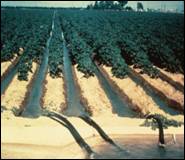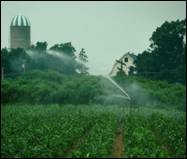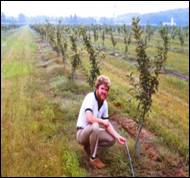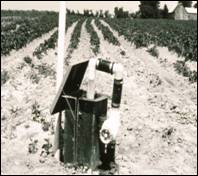- Surface Drainage
- Subsurface Drainage
- Random Layout
- Pattern Layout
Surface Drainage
Surface drainage is the shaping, grading, or management of the land surface to provide gradual removal or diversion of water off of the land surface. Surface drainage is accomplished by smoothing out small depressions (land smoothing) or regrading an undulating land surface to a uniform slope, and directing water to a natural or improved, constructed channel. Ridge tillage is a form of surface drainage, providing excess water that accumulates between the ridges can flow away. Soil aeration or coring is also a form of surface drainage if it facilitates infiltration of water into an unsaturated subsoil. Surface drainage refers to the orderly removal of water, both within a field or to the removal of excess water off site.
Advantages of surface drainage are to minimize the duration of ponded water that inundates crops, and to minimize the prolonged saturation of soil which restricts gas (oxygen and carbon dioxide) exchange with the soil and plant root system or which prevents cultural operations. Surface drainage is most advantageous on flat lands where slow infiltration, low permeability, or restricting soil layers prevent the ready infiltration of high intensity rainfall.
A disadvantage of surface drainage is that it has a minimal affect on reducing the saturated subsoil occuring as a result of high water table conditions, especially where the source of the water is emerging from lower horizons. Other disadvantages are that if the water is not removed in an orderly manner, soil erosion may occur, and nutrient and other contaminants may be carried off in the runoff. Phosphorus and many herbicides are normally bound near the soil surface, and these may be transported in the surface drainage water.
Subsurface Drainage
Subsurface drainage is the removal of excess drainable porosity water in the subsoil, with the aim of lowering or controlling the water table depth below the crop root zone. Subsurface drainage is usually implemented with the use of buried corrugated (and perforated) plastic or clay (tile) conduits, but it can be done also by creating an unlined pore (mole drain), constructing blind (or French) drains, excavating deep open drains, or by the use of tubewells (shallow groundwater wells).
A subsurface drain must be installed below the water table (so water can flow from higher to lower energy state) or it will not work. Once the water table drops to the same elevation as the drain, the drain will no longer flow. The primary advantage of subsurface drainage in humid regions is the water table can be lowered so soils classified as poorly drained can be improved to respond more like well drained soils, with the benefits of improved productivity and trafficability. In arid regions, the advantage is mainly to minimize the buildup of excess salinity in the crop root zone.
A disadvantage of subsurface drainage is that its often more costly to implement per unit area compared to surface drainage, especially for fine textured soils. Also, if water ponds on the surface because of surface sealing or a shallow compact layer (plowpan, fragipan), subsurface drainge is not effective in removing this excess water. The environmental disadvantages related to drainage implementation are poorly drained, wetland type habitats may be modified, and the drainage discharge water may carry unacceptable contaminants. Since subsurface drainage lowers the water table and facilitates aerobic soil conditions, nitrification is enhanced and high nitrate concentrations may occur in the drain discharge water.
|






